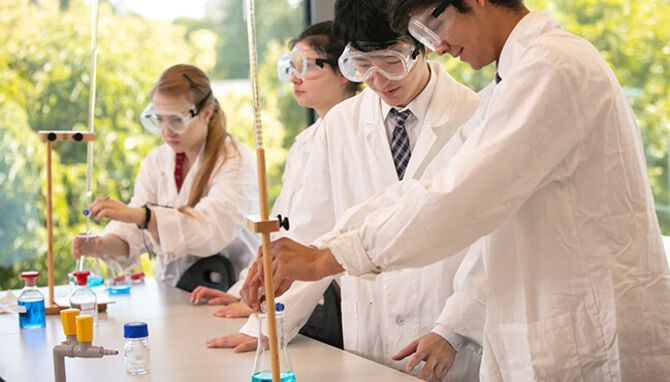Letting off STEAM: international schools spark the imagination
With STEM subjects of increasing importance in a competitive world, we take a look at the initiatives in international schools around the world that are fuelling student ambition for technical careers.

The British School Warsaw, Poland
 But international schools around the world are rising to the challenge with innovative ideas to excite pupil’s about careers in STEM and to encourage girls into fields such as engineering that have historically been male-dominated. We take a look at some of them.
But international schools around the world are rising to the challenge with innovative ideas to excite pupil’s about careers in STEM and to encourage girls into fields such as engineering that have historically been male-dominated. We take a look at some of them.Seisen International School, Japan
Seisen International School, an all-girls international Catholic school in Japan is helping students to pursue science ‘in the real world’ through its Firebird initiative – a competitive science team. Firebird takes part in the Conrad Innovation Challenge, The Japanese Science and Engineering Challenge and Google Science Fair.In 2015, five members of the original Firebird team invented the NASoPod, a portable and renewable energy heater that works without fossil fuels or electricity. In 2016 the team travelled to the Kennedy Space Center to present their invention in front of the judges. It resulted in the team of students filing a patent application and receiving requests to take the NaSoPod into production.Last year saw inventions from the team such as Bonometal – a biodegradable material used to make screws and plates to repair broken bones instead of metal or plastic and Hydroshield 15 – a special fabric to protect astronauts from Galactic Cosmic Rays.“The Firebird Science Team is a great opportunity for students to use their knowledge and skills gained from many disciplines to make the world a better place, and to prove that scientific innovation can flourish in an all-girls school,” said Youkie Shiowzawa, class of 2018 and Firebird member.ACS International Schools, UK and Qatar
ACS International Schools help their students to understand that their knowledge of a subject is not just confined to the classroom. An annual ‘Maker Day’ at ACS Cobham in Surrey encourages students of all ages to create anything, “From simple arts and craft designs to complex computer science projects,” explains Mark London, head of Marketing for the schools’ group.“The summer Maker Camp involves creative technology activities, including making battery powered cars and trucks; building mechanical moving robots; and designing and installing water irrigation systems for the school’s vegetable gardens,” he says. “By putting STEAM learning directly in their hands, students build confidence to ask questions, define problems and design their own solutions.”High tech facilities, such as a new £10 million science centre at ACS Hillingdon with seven state-of-the-art laboratories, a microbiology unit and new technology lab show the groups’ commitment to enhancing science learning.Concordia International School, China
Ryan Maney, Elementary STEM coach at Concordia International School Shanghai believes that a key facet to a strong STEM programme is offering a variety of electives and after school courses for students.“Our Co-curricular activities include a number of STEM opportunities,” he says. “These include First Lego League Robotics, HighFour Math, Video Production and much more. The uniting thread amongst all of the STEM electives is that they require students to think critically, collaborate with others and solve real world problems. By developing these skills in our students, we create global citizens who are ready to make positive contributions to our society.”Each section of the school (Elementary, Middle and High School) has a designated Makerspace. “These spaces are an area for students to inquire, imagine and collaborate on projects that span the curriculum. It is through creative problem solving that some of the world’s biggest dilemmas will be solved. We hope to equip our students with these skills in the Makerspace,” he says.British International School of Chicago, Lincoln Park (BISC-LP), USA
Part of the Nord Anglia Education Group, BISC-LP has been an early adopter of the STEAM movement. The school’s collaboration with the Massachusetts Institute of Technology (MIT) aims to enhance the teaching of STEAM by connecting MIT innovation and culture with the school.Explains STEAM leader, Tom Collins, “The importance of STEAM comes at a time when colleges such as MIT are lamenting the lack of ‘outside the box’ thinking from undergraduate students. Knowing how to use technology or complete complex mathematics; being able to use the scientific method or engineer simple products does not mean that one is using creative thinking. Innovation comes from human experience and human experience happens through engaging with the arts.This year the MIT challenge is ‘Navigating Tomorrow’ which encompasses three areas:- Street Smarts – looking at the future of self-driving cars, mapping skills, robotics and coding
- Greener Skies – designing a fuel-efficient aircraft. Students will have a wind tunnel to investigate aerodynamics.
- Rethink/ Refuel – looking at the future of fuels, biofuels, land use and the growth of renewable energy.
Meadowridge School, Canada
Helping students to see how maths skills could be applied in the real world is a challenge that Maths teacher and IB MYP coordinator at Meadowridge School, Scott Rinn was keen to rise to. He has been working over the past two years to bring maths to life. “We need to get students using math to solve real problems,” he says. Then one day a perfect opportunity for students to use their maths skills in the real world came along: subdividing the grounds of the headmaster’s property.“When I looked at the plot, the first thing that jumped out at me was that there were a hundred different ways the children could solve this problem,” explains Mr Rinn. “Not only could the lot be subdivided in myriad of ways, but students could apply an equal number of mathematical equations and concepts to get there.”The groups were tasked with three requirements: the lot had to be split exactly in two, the current home had to fit on one of the lots and a second driveway must be added to access the second lot. Students could use whichever concepts they saw fit. “Students used all types of concepts in differentiated approaches. There was no set instruction for the types of Math they had to use which was perfect; all of the students’ answers were spot on,” says Mr Rinn.He continues to seek out real world projects to bring maths to life. “I just want them spending more time solving real problems, not just hearing from me how they could.”Tanglin Trust School, Singapore
To support the increasing demand for Design and Technology (D&T) as a standalone course, Tanglin Trust School, a British International School catering for students from age three to 18 has built a new D&T facility which includes a Design Suite, materials ‘Shed’, workshop and Computer Aided Design (CAD) and Computer Aided Manufacture (CAM) areas.“Each area supports students in the development of problem-solving skills and to design and create using the tools that best suit the process and product, whether manual, digital or a combination of both,” explains James Bleach, head of D&T.Students have access to all types of machinery in the Workshop and learn to model ideas in 2D and 3D in the CAD area and then be created using (amongst other tools) 3D printers. “The enthusiasm and ability of the first studnets to use this space has shown their readiness to use technology in a way that will impact positively on our world and theirs moving forward,” says Mr Bleach.Jerudong International School (JIS), Brunei
Claire Gillam, digital coordinator at JIS, a British international boarding school in Brunei with the largest international school campus in the world, believes that the school’s outstanding facilities provide students with opportunities like never seen before.“We are fortunate enough to have numerous 3D printers and laser cutters and even a CAD/CAM router. This access to Computer Aided Manufacture equipment has allowed our pupils to design and realise products and prototypes that would once have only been available to engineers and industrial designers,” she says.“At JIS we have an ‘anywhere, anytime’ approach to how we use technology for learning. We have found that having the ability to use technology whenever we wish has led to a more blended learning environment. Technology has slowly become integral to what we do, not the driving force behind what we do.”This snapshot of some of the exciting initiatives in international schools around the world will reassure families on a relocation that schools around the world are recognising the need to invest in their STEAM education, providing students with opportunities on a global scale.
Now available as an ebook on Amazon! Simply download from Amazon onto your Kindle, mobile phone or tablet to read wherever you are!
For more education and school related news, visit our Education and Schools pages.Access hundreds of global services and suppliers in our Online Directory© 2018. This article first appeared in the 2018 edition of the Guide to International Education & Schools published by Relocate Global, Spray Hill, Hastings Road, Lamberhurst, Kent TN3 8JB. All rights reserved. This publication (or any part thereof) may not be reproduced in any form without the prior written permission of Relocate Global. Relocate Global accepts no liability for the accuracy of the contents or any opinions expressed herein.


























